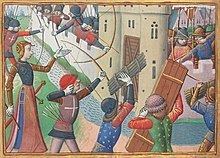Dates 3 Sep 1429 – 8 Sep 1429 | Result French defeat | |
 | ||
Similar Hundred Years' War, Battle of the Herrings, Battle of Meung‑sur‑Loire, Battle of Patay, Siege of Orléans | ||
The siege of Paris was undertaken in 1429 by the French troops of King Charles VII, with the notable assistance of Joan of Arc, to take the city held by the allied Anglo-Burgundian. The royal troops fail to enter Paris, defended by the governor Jean de Villiers de L'Isle-Adam and the provost Simon Morhier.
Contents
Background
After the capture of Paris by Henry V of England in 1420, the English administration was sympathetic to the citizens of Paris, confirming their former privileges and giving even new ones.
The Parisians had accepted the English mostly by hatred of Charles VII, whom they had nicknamed "King of Bourges", and the Armagnac party that threatened the many liberties that the city had obtained over the centuries. After the battle of Montépilloy on 26 August 1429, Joan of Arc and the Duke John II of Alençon take Saint-Denis, a town north of Paris. On August 28, Charles VII signs the truce of Compiègne which excepts from the armistice Saint-Denis, which was already taken, St. Cloud, Vincennes, Charenton and Paris.
The battle
In early September, Charles VII established his camp to the butte de Saint-Roch.
On September 3 Joan of Arc accompanied by the Dukes of Alençon and Bourbon, the counts of Vendôme and Laval, Marshals Gilles de Rais and La Hire and their troops, lodge in the village of La Chapelle . After performing for several days recognitions and skirmishes on various gates of Paris, Joan of Arc pray in St. Genevieve chapel. In the morning of Thursday, 8 September 1429 Joan of Arc, the Duke of Alençon, Marshals Gilles de Rais and Jean de Brosse Boussac start from the Village of La Chapelle to storm the Porte Saint-Honoré. Jeanne Arc installed culverins on the butte de Saint-Roch to support the attack.
The Parisians, believing that the Armagnac wanted to destroy the city from top to bottom, made a vigorous defense. Trying to cross the moat filled with water in front of the gate, Joan of Arc was wounded by a crossbow bolt in the thigh. Joan was brought back to her house in La Chapelle. Although she wished to resume the attack on Paris, the king ordered her to withdraw to the Abbey of Saint-Denis. After 4 hours of assault, the King sounded the retreat.
Consequences
The city was defended by about 3,000 English, with much of the population of Paris, commanded by Marshal Simon Morhier and Governor Jean de Villiers de L'Isle-Adam, which forced the King of France to retreat.
Having failed by force, Charles VII, tried to take the city otherwise, in 1430, he staged a plot that was discovered by the English, failing with the hanging of 6 Parisians on the scaffold. Seven years later, on April 13, 1436, the Parisians themselves open the gates to bastard of Orleans, constable Richemont and the troops of the Duke of Burgundy, who managed at the time to choose a new ally, as a result of the Treaty of Arras.
